Your cart is currently empty!
At Coachella, notions of justice soar stories tall

Coachella Valley Music and Arts Festival has a long-held reputation of being a Janus-faced site of indulgence, friendship, fashion, vanity, untethered joy, and increasing crowds. Upon its much-anticipated return after two years of closure due to a pandemic that changed the world, remarkably, little has changed on the polo fields. Half-naked young people en masse ingest non-inhibitors, embracing one another with gusto, skipping between stages and art installations, drinking in the desert’s constantly shifting, surreal environment.
It’s not the environment one conjures when imagining the ideal location to host serious conversations about politics or a shared daily despair due to an impending and very certain apocalypse. Still, it can be argued that these conversations ought to be hosted in large public forums no matter the circumstance, especially when the Gen Z and Millennial leaders of our future are keen to influence, and be influenced.
The art projects at Coachella have historically been adored by its attendees, as they are always a delight; playful and engaging. This year is no exception, yet, the tune set by the festival’s art team has notably shifted. More of its specially-commissioned site-specific installations demand its audience consider notions of social justice and environmental sustainability, “from use to re-use, up-cycling to re-cycling, multi-cultural dialogue, immigration, community and exchange, social behavior and architecture, performance and pop culture” (Coachella). As Paul Clemente, art director for 15+ years, reminds me, Coachella is “inherently an arts organization promoting punk rock and artists who radically express themselves in whatever way they want to.”
So, what are Clemente’s top priorities when curating a series of radical installations for the fields in 2022? He put it simply: “we’re really looking at inclusivity straight out the gate… to produce art without meaning is a waste of time, in my opinion.”
Here are some of the art installations at Coachella kicking up a storm this year.
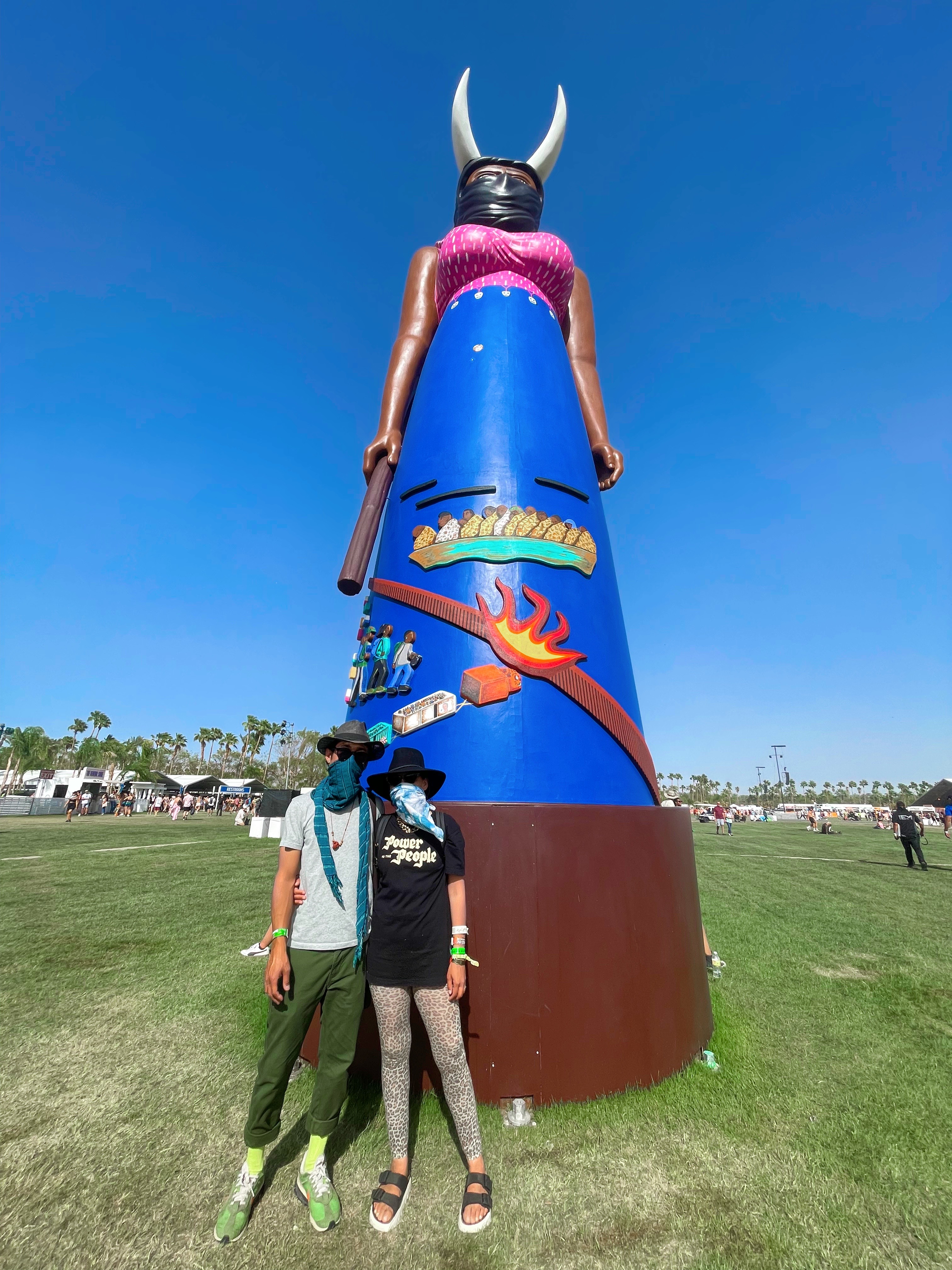
LosDos – La Guardiana
El Paso, Texas-based artists Ramon and Christian (Chris) Cardenas, aka LosDos, are a husband-and-wife duo known for murals, screenprints and street poster installations, drawing inspiration from their everyday lives in El Paso and Juarez, Mexico. At the US-Mexico border between these cities, femicide is a crisis. Migrant women are “easy targets, because their family members were hard to reach in case something happened to them… they were easy to disappear,” says Chris, who is an immigrant herself.
La Guardiana towers over the festival grounds, wearing a pink shawl to carry her child, a blue skirt featuring scenes of migrants crossing borders by foot and boat, a black mask to conceal her identity, and white horns to signify strength. A symbol of love and solidarity, La Guardiana’s pink shawl represents the Ni Una Mas movement created by the mothers and family of disappeared women in Juarez; while the blue skirt stands for the Mexican labor movement, denim, and workers’ rights.
Presenting their work at Coachella “brings us a new audience,” says Ramon. “It really talks about something important, what’s happening now.” Chris adds, “peoples’ movements are really pushing a life of liberty and justice, and we think it’s good to pay attention. We all have something to learn from these movements.”

On the first weekend of the festival, guests could be seen sincerely embracing La Guardiana. And one of the least-represented communities at Coachella – the local Latinx laborers – “connect with it,” says Chris. “They let us know they appreciate the work because they feel represented. We had many conversations with workers who had these things to say. That extends to the public… we have met people that appreciate that their stories or struggles are being represented here.”
“Having the LosDos piece here this year is really important,” says Clemente. “It’s an important piece for the East Valley; it’s an important piece for the country right now.”

Cristopher Cichocki – Circular Dimensions x Microscape
Cristopher Cichocki, a local Coachella Valley resident, creates “new earth art” interventions as well as sound, video and installation works informed by biomorphic painting “at the intersection of the natural world and industrial manufacturing – really, the mutation between those two elements,” says Cichocki. His 5-story bandshell-shaped pavilion made from over 25,000 feet of PVC tubes – the most common conduit of water and, surprisingly, a sustainable material – is a comment on interconnection, water, environment and sustainability. “We’ve demonized plastic, and yes, for good reason,” says Cichocki. “It was important for me to design something that could be sustainable not just for the course of the festival… by all means, this will exist well into the future. Probably, longer than I live.”
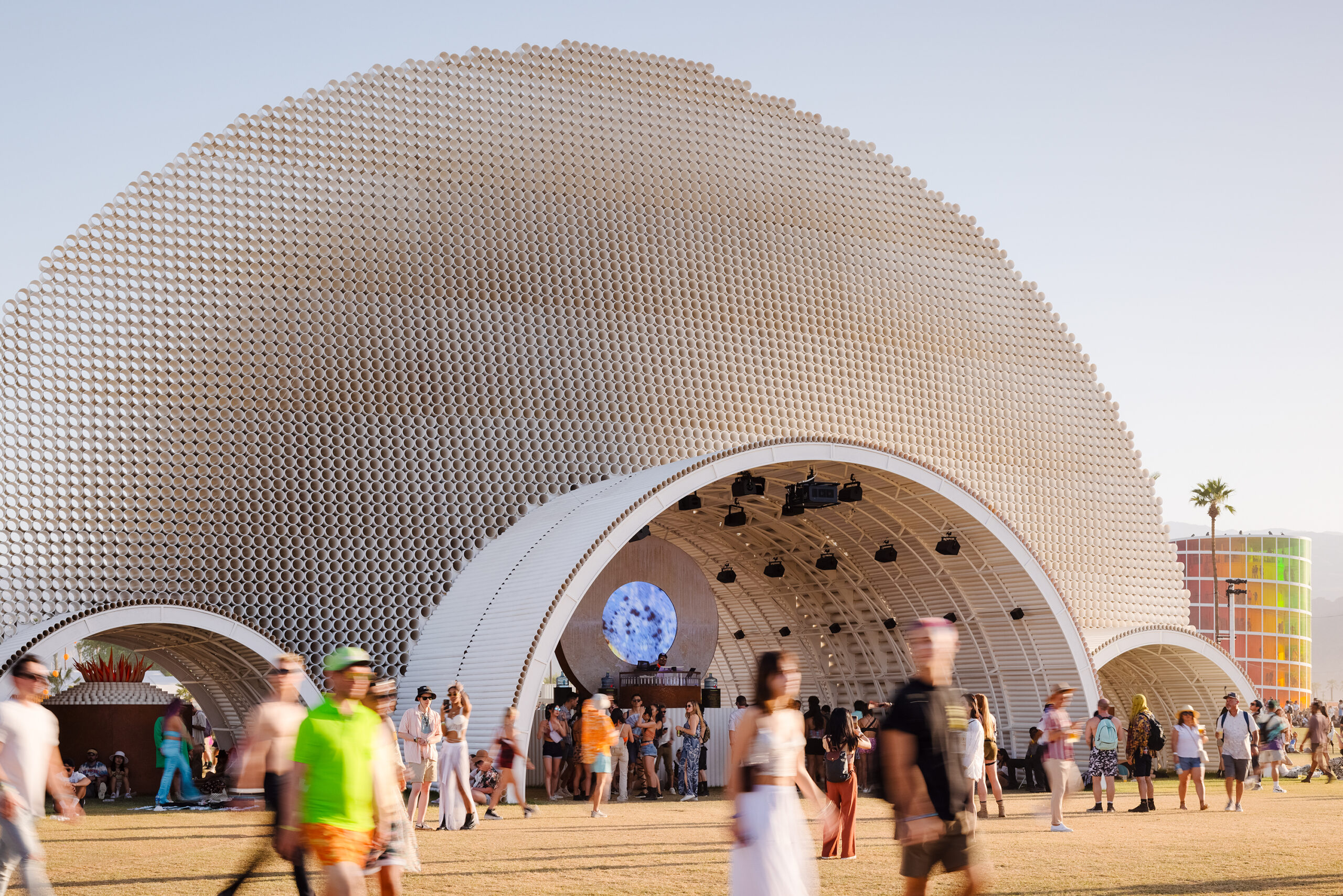
Cichocki’s pavilion presents a central laboratory activated by artists and scientists who manipulate materials from the Salton Sea under a microscope to create live “video paintings” that are projected in real time in the pavilion’s “nucleus.” At nighttime, Cichocki’s audiovisual performance Circular Dimensions sends visual and sonic vibrations through the work, projecting visuals onto the entire facade and activating the interior with future bass and experimental “sound collages.”

L-acoustics, the top high-fidelity speaker manufacturer in the world, flew 60 speakers out for this installation, and Cichocki worked with sound designers to develop custom software that allows him to manipulate sound like an object in the pavilion’s tunnel. “I’m able to do things like have it spiral, float above the space, and drop down immediately,” says Cichocki. “The dimensionality is what L-acoustics likes to call ‘hyper-real immersive sound.’”
In one tunnel of the pavilion, visitors encounter a “mutant” cast resin aloe vera. “A surviving seed” from the desert’s ancient sea, it is both a celebration of the resilient natural life that blooms in the desert and a cautionary tale. The artist hopes his installation helps visitors understand, “we really need to get our act together. Because, we only have a few years left to save the planet, and I don’t see that happening.”

Architensions – The Playground
Alessandro Orsini and Nick Roseboro make up the architectural design and research studio Architensions, based out of New York and Rome. They came to Coachella with one lofty goal: to make a public, spacial playground where the visitor would become the performer in such a genuine manner as to disengage from the performative aspects of Instagram.
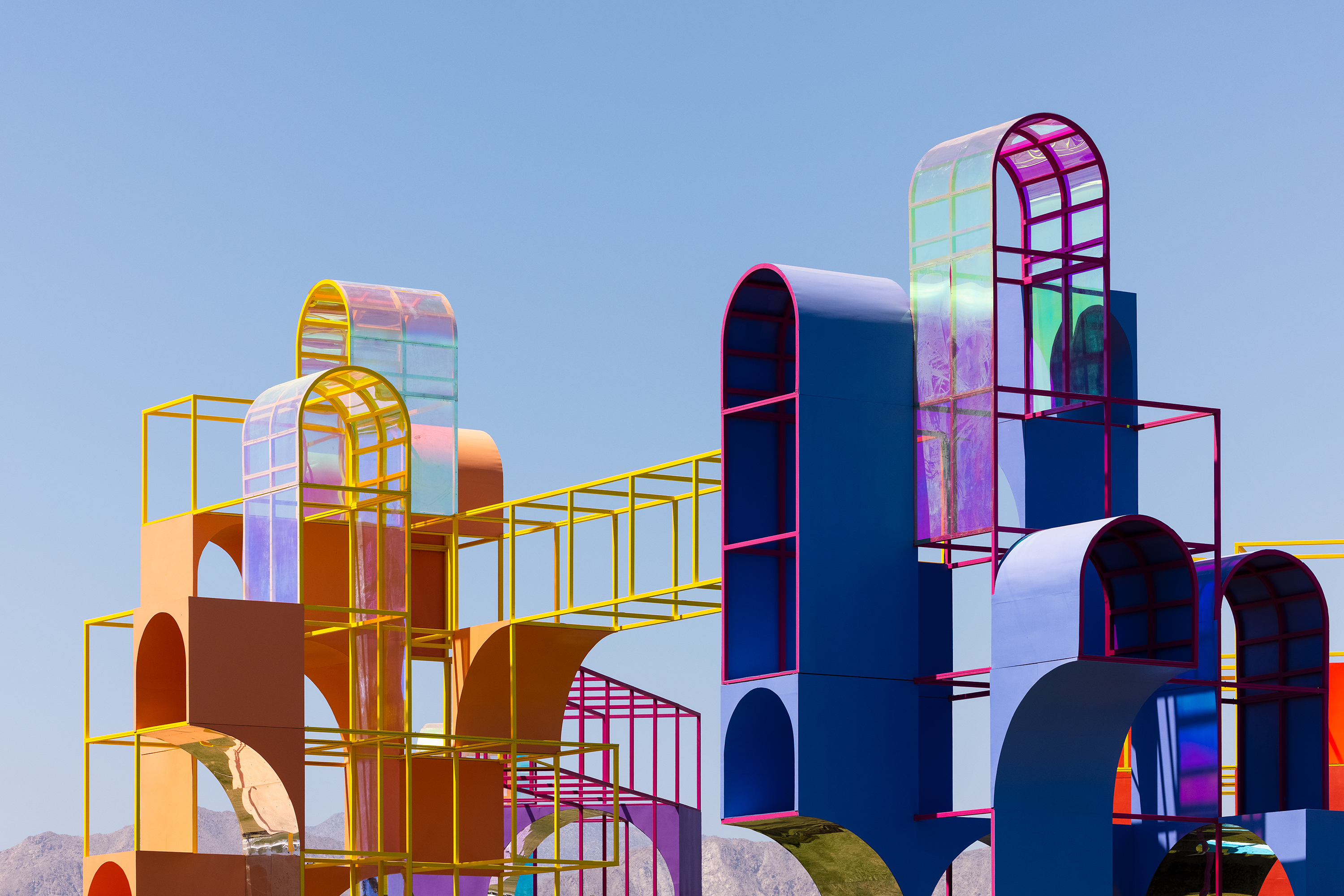
This year’s central meeting point on the polo fields, The Playground’s fragmented towers are covered in mirrors, dichroic film, and desert hues of pink, purple, yellow and orange. Instead of individuals taking selfies, the installation was bustling with groups of friends gathered in a large central area for pictures, couples posed for a quick snap laughing candidly, and budding portrait photographers crawling on the grass to get the perfect angles of their crew.
And then, they put away their phones, and kept playing.
Orsini and Roseboro celebrated this small but significant victory. At Coachella, if a phone gets put away for even a moment, the festival has built a safe space, where guests feel entertained, confident, and content. “It’s impossible to break away from the technology of a phone,” admits Roseboro, “the idea is to create a new architectural device that is enabling us to interact with each other in a different way.”
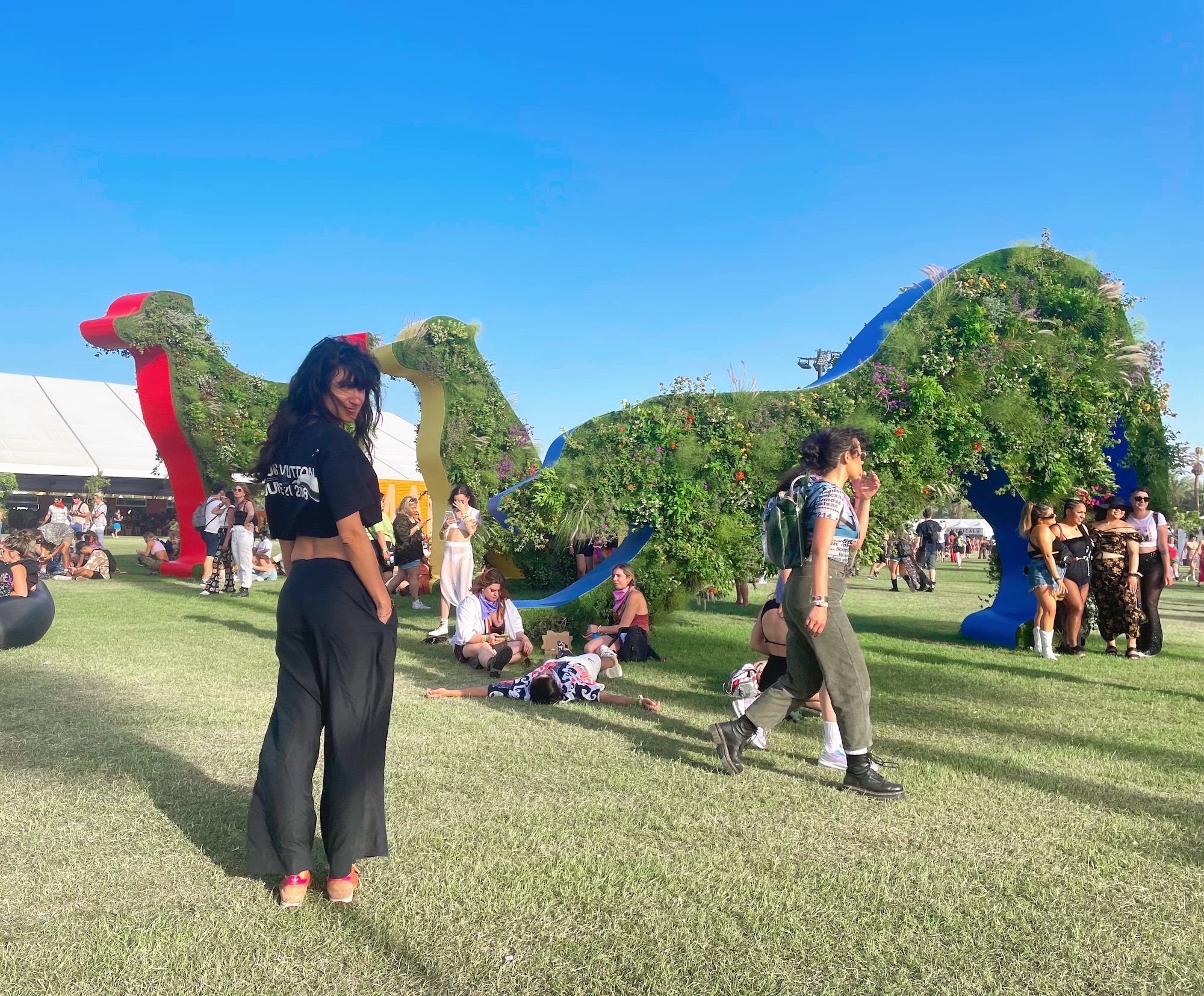
Oana Stănescu – Mutts
The silhouettes of three oversized dogs in states of rest can be found just behind the Outdoor Stage. Oana Stănescu, the Romanian architect whose own mutt Perry inspired these works, thinks of the installation as “a little bit like an ode to life, if that’s not too much to ask of it.”
As it turns out, it’s not. These Mutts are living sculptures, with flora for fur that gently blows in the ever-present desert wind. They are a celebration of an intermingling that happens at every level of species, from human to dog, and plants to animals. In the shade of these familiar, comforting forms, visitors generally matched the relaxed repose of the mutts, exhibiting extra sensitivity in their gentle interaction with the fragile plants.

“Were it not for plants and animals on this earth, we wouldn’t be. I think we have a lot to learn from that,” says Stănescu. A comment on the imperative nature of coexistence and interdependence, the artist hopes her work reminds us that “we live in their world – we just tend to forget it.”
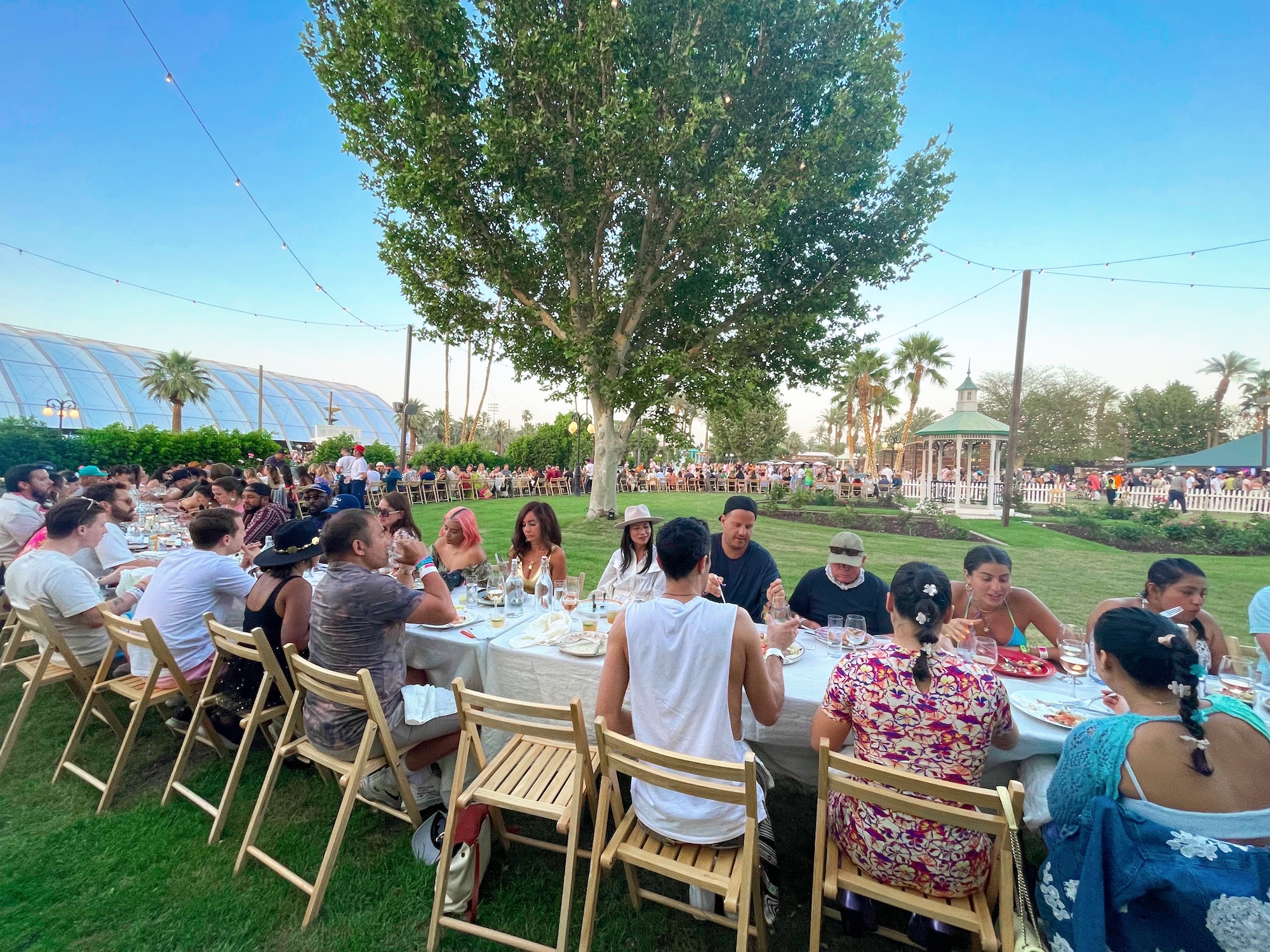
I wrapped up a hectic day of trying to locate relative strangers at crossroads in the fray and screaming interview questions over blaring music with a very welcome respite – a ticket to a four-course gourmet dinner hosted by Outstanding in the Field on the festival grounds, in the Rose Garden.
Outstanding in the Field, a truly unique cuisine, art and social experience led by land artist Jim Denevan, is a practice in excellence. Guests of Outstanding in the Field are treated to multi-course, local, farm-fresh dinners on their legendary long dining tables in the most unusual and attractive locations. They have hosted one-of-a-kind dining experiences in the Los Angeles River, on private beaches or in tropical waters during low tide, and, of course, in fields and meadows all around the world. And, for the last seven years, they have set their tables for three meals both weekends of Coachella. Tickets are hard to come by and expensive, but if you can snag yourself one of the 150 seats, you’re guaranteed an indulgent two hour re-charge from the chaos just out of arm’s reach on the fields.
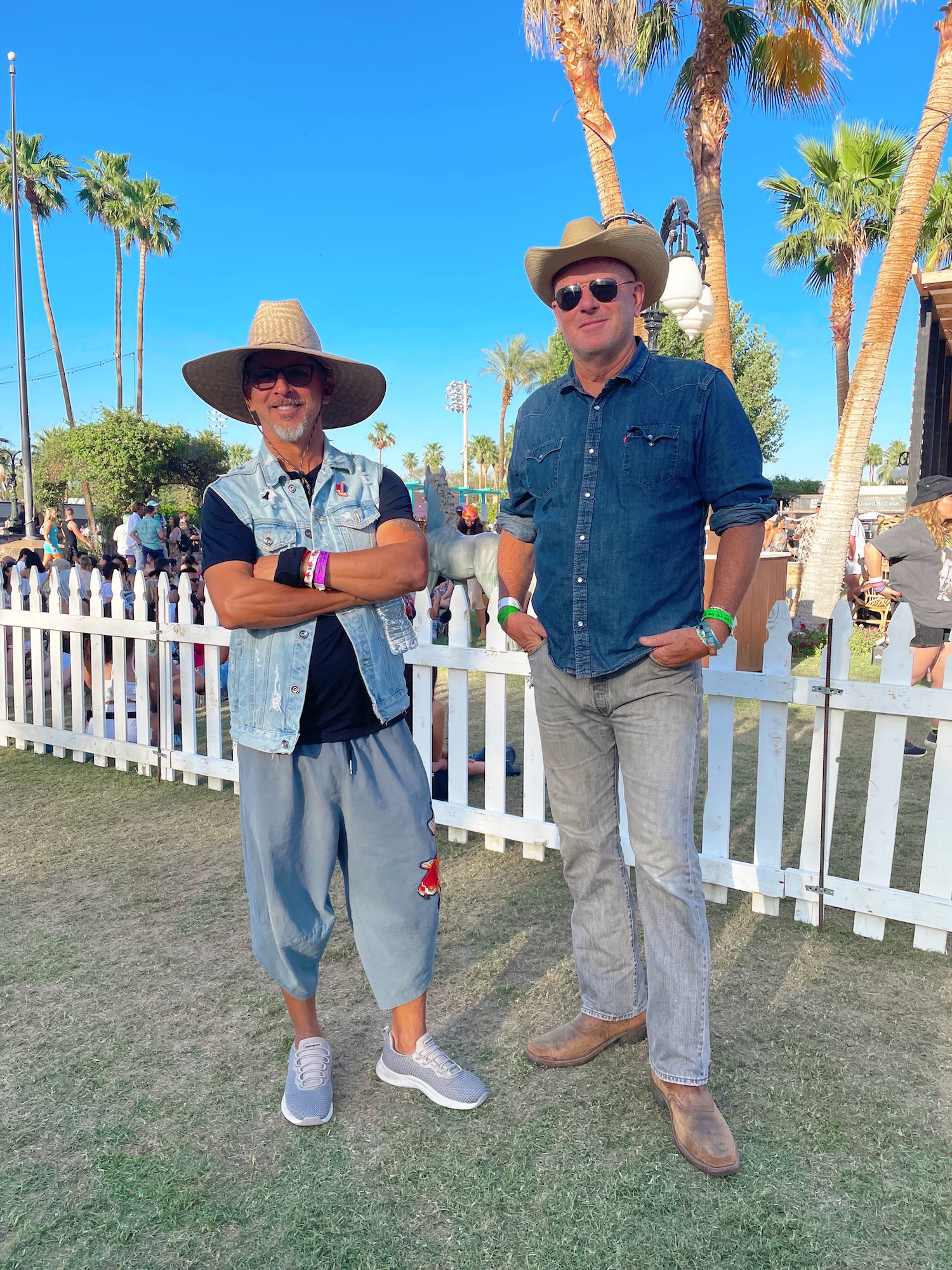
“This is an environment where people will sit with creative, interesting people,” says Denevan. “It’s random. There’s no assigned seating. The food’s fantastic, it’s from local farms. We got great chefs. To me, the coolest thing about it is the conversations happening at the tables.” The only thing Outstanding in the Field at Coachella is missing from its typical formula of success is a large-scale installation by Denevan in the landscape. Rest assured – one is coming, and it will also be Denevan’s brand of fantastic.
At the end of a lauded festival filled with world-class music, art, and friendship, if Coachella does its job right, the conversations we have will be the memories we keep.
Comments
2 responses to “At Coachella, notions of justice soar stories tall”
This is so awesome! You nailed it.
Stupendous!